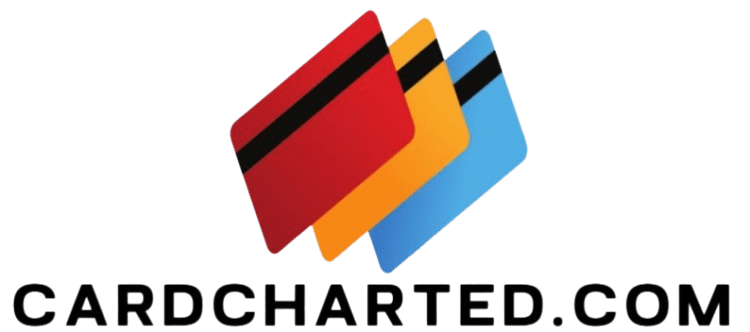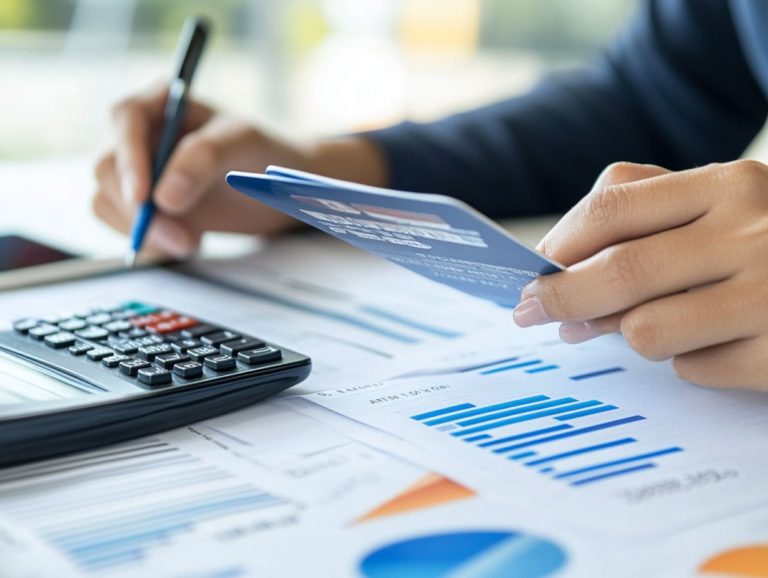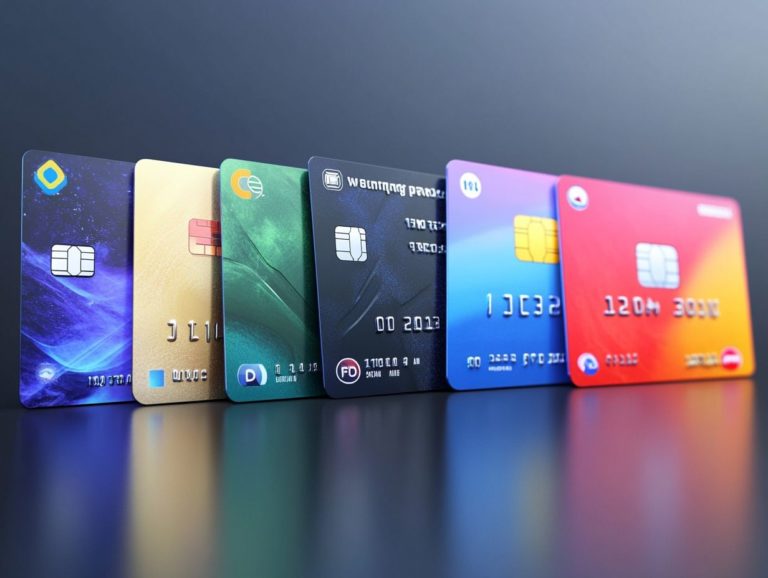Choosing Between Fixed and Variable Rate Business Cards
Navigating the world of business credit cards can feel like a daunting task, particularly when you’re faced with the choice between fixed and variable rates. Each option comes with its own unique benefits and drawbacks that can profoundly influence your financial landscape.
This article delves into the definitions and distinctions between fixed and variable rates, while also exploring the pros and cons of each type. You’ll uncover key factors to consider based on your specific business needs and current market trends.
By the end, you’ll be well-equipped to make a decision that perfectly aligns with your financial aspirations.
Contents
- Key Takeaways:
- Understanding Fixed and Variable Rates
- Pros and Cons of Fixed Rate Business Cards
- Pros and Cons of Variable Rate Business Cards
- Key Factors for Choosing Fixed vs. Variable Rates
- Making the Final Decision
- Frequently Asked Questions
- What are the main differences between fixed and variable rate business cards?
- How do I know which type of business card is right for me?
- Are there any advantages to choosing a fixed rate business card?
- On the other hand, what are the benefits of selecting a variable rate business card?
- Can I switch between fixed and variable rate business cards?
- Is it possible to have a combination of fixed and variable rates on one business card?
Key Takeaways:

- Fixed-rate business cards offer stability and predictability in monthly payments, but can be higher than variable rates in the long run.
- Variable-rate business cards have lower initial rates, but can fluctuate with market trends and may result in unexpected increases in payments.
- When choosing between fixed and variable rates, consider your business needs and goals, as well as market trends and predictions. Seek professional advice to help make the best decision for your business.
Understanding Fixed and Variable Rates
Understanding the nuances of fixed and variable rates is essential for making informed borrowing decisions. Fixed interest rates provide a sense of predictability in your loan repayments, allowing you to budget with confidence.
In contrast, variable interest rates can dance with the market, leading to fluctuations that could impact your financial landscape significantly. This is especially true when it comes to personal loans and credit cards.
As market interest rates and economic conditions shift, it s imperative for you to review your financial situation. This self-assessment will guide you in determining which option resonates with your financial goals and risk tolerance.
Whether you re contemplating mortgage refinancing or exploring various borrowing products, a firm grasp of these concepts will undoubtedly bolster your financial stability.
Definition and Differences
Fixed interest rates remain steady throughout the duration of your loan, while variable interest rates fluctuate based on current market conditions and the prime rate, which is the interest rate that banks charge their most creditworthy customers.
This fundamental difference has a significant impact on your financial strategy. With fixed rates, you can enjoy the comfort of predictable monthly payments, making it easier for you to budget over the life of a mortgage or personal loan.
On the flip side, variable rates might entice you with lower initial payments, but they can introduce a level of financial uncertainty if market rates begin to rise. For example, you could snag a fantastic low interest rate at first, only to find yourself facing higher payments as market conditions change.
These distinctions not only guide your loan selection but also play a crucial role in your long-term financial health. You ll need to consider your capacity to adapt to fluctuating rates.
Pros and Cons of Fixed Rate Business Cards
Fixed-rate business credit cards present a host of advantages, such as budgeting predictability and stable cash flow management. These features make them an appealing option for businesses aiming to exert effective control over their financial management.
Advantages and Disadvantages
The advantages of fixed-rate credit cards lie in their predictable payments and minimized financial risks. However, the drawbacks may include higher initial rates and limited flexibility in adapting to market changes.
These fixed payments provide a sense of security, especially for those who value stability in their budgeting. Knowing exactly what you need to pay each month allows for more confident financial planning, reducing the anxiety associated with unexpected rate increases that can disrupt your cash flow.
It s important to remember that while those initial rates might catch your eye, they can often be higher than those of variable-rate cards, potentially leading to greater overall costs down the line. The rigidity of fixed-rate options can be a disadvantage during economic fluctuations, where more adaptable credit solutions might offer better terms suited to your shifting financial landscape.
Don t wait too long to make your decision; the right credit card can make a huge difference for your business!
Pros and Cons of Variable Rate Business Cards

Variable-rate business credit cards present a mix of advantages and drawbacks. They offer lower initial rates, providing tempting savings. However, the unpredictability of fluctuating loan repayments can complicate your financial planning.
Advantages and Disadvantages
The advantages of variable-rate credit cards are appealing. They offer lower initial rates and the potential for savings when interest rates are stable.
However, be aware of the disadvantages. Payments can increase with interest rate fluctuations, impacting your money coming in and going out.
If the economy has low interest rates, you could enjoy financial flexibility and reduced borrowing costs. Yet, sudden rate hikes can escalate your monthly expenses, putting pressure on your ability to repay.
For those relying on variable-rate credit, managing cash flow can be challenging, making it hard to maintain timely payments. Grasping this balance can save you money and stress.
Key Factors for Choosing Fixed vs. Variable Rates
When weighing the choice between fixed and variable rates, consider several factors. Your financial goals, risk tolerance, and the current interest rate landscape are crucial for making an informed decision.
Understanding market trends and your borrowing habits can improve your decision-making process.
Business Needs and Goals
Understanding your business needs and goals is vital when deciding between fixed and variable rates. This choice directly impacts your cash flow and long-term financial health.
Analyze factors like revenue stability and anticipated expenses to determine which rate structure aligns with your financial strategy.
If predictable budgeting is your focus, you may prefer fixed rates, which provide consistent repayment amounts. Conversely, if your income fluctuates, variable rates might attract you for their lower initial payments, but watch out for the risks tied to market dynamics.
Ultimately, evaluating your ability to pay back loans is crucial; it shows how well you can manage your financial commitments without risking your liquidity.
Market Trends and Predictions
Market trends and predictions are essential in your decision-making process between fixed and variable rates. Fluctuations in economic conditions can significantly impact future interest rates.
For businesses navigating borrowing complexities, staying informed about these variations is imperative. By monitoring interest rate trends, you can craft strategies that mitigate risks from potential economic downturns or unexpected cost increases.
Understanding market dynamics enables you to position your organization advantageously. This ensures you choose the most suitable financing options that align with your growth objectives. This proactive approach fosters financial stability and empowers your business to seize favorable lending conditions as they arise, enhancing your competitive edge.
Making the Final Decision

When making your final decision between fixed and variable rates, consider all factors carefully. This includes assessing your borrowing habits, evaluating your ability to pay back loans, and aligning with your overall financial management strategy.
Evaluating Your Options
Evaluating your options means diving deep into various borrowing decisions aligned with your financial goals, loan amounts, credit status, and risk tolerance. This careful analysis gives you the power to make an informed choice between fixed and variable rates.
To effectively navigate these options, start by examining your personal financial profile. Take a close look at your income, existing debts, and savings. It s essential to consider your long-term objectives as well whether that s home ownership, funding education, or making business investments.
Understanding your credit status plays a crucial role in shaping the terms and amounts available to you. Lenders check your credit score to determine your eligibility and risk. By grasping this concept, you can position yourself more favorably to negotiate loan conditions that resonate with both your current financial situation and your future ambitions.
Seeking Professional Advice
Seeking professional advice is crucial for making smart choices when navigating the complexities of fixed and variable rates. Experts can offer tailored insights into financial management and effective borrowing strategies that reflect the ever-changing economic landscape.
Their expertise allows you to grasp the nuances of each loan type, ensuring your decisions align with your personal financial objectives and long-term goals. By analyzing various loan features such as interest rates, repayment terms, and potential penalties these professionals empower you to assess your options with confidence.
Seasoned advisors stay updated on market trends and regulations, enhancing their ability to recommend strategies that mitigate risks while maximizing benefits. Consulting financial experts creates a roadmap, guiding you toward borrowing choices that not only meet your immediate needs but also support your future aspirations.
Frequently Asked Questions
What are the main differences between fixed and variable rate business cards?
Fixed rate business cards have a set interest rate that remains the same for the entire duration of the card, while variable rate cards have an interest rate that can change based on market conditions. To learn more about selecting the right card, check out our guide on how to choose between personal and business credit cards.
How do I know which type of business card is right for me?

The decision between fixed and variable rate business cards ultimately depends on your financial goals and risk tolerance. If you prefer predictable payments, a fixed rate card may be a better option. However, if you are comfortable with potential changes in interest rates, exploring credit card comparison: fixed vs. variable rates may reveal that a variable rate card offers more flexibility.
Are there any advantages to choosing a fixed rate business card?
Fixed rate business cards provide stability and predictability in monthly payments, making budgeting and planning easier. They are also less affected by market fluctuations, providing a sense of security for businesses.
On the other hand, what are the benefits of selecting a variable rate business card?
Variable rate business cards often come with lower introductory rates and the potential for lower overall interest rates if market conditions remain favorable. They also offer the opportunity to take advantage of potential decreases in interest rates.
Can I switch between fixed and variable rate business cards?
In most cases, yes. However, there may be certain restrictions or fees associated with switching between the two types of cards. It’s important to carefully consider your options and potential costs before making any changes to your business card.
Is it possible to have a combination of fixed and variable rates on one business card?
Yes, some financial institutions offer hybrid business cards that have a fixed rate for a certain period of time and then convert to a variable rate. This can provide a balance of stability and potential for savings.






